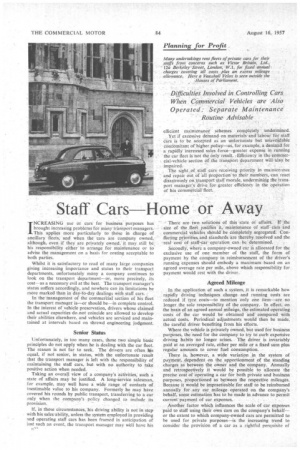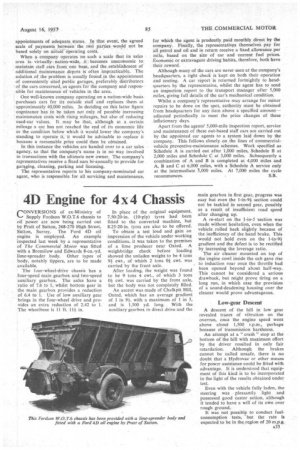Staff -00.5
Page 56

Page 59

If you've noticed an error in this article please click here to report it so we can fix it.
Home or --.:Awdy
INCREAS1NG use ot cars for business purposes has . brought increasing problems for many transport managers. • This applies more particularly to those in charge of . ancillary fleets, and when thecars are company owned, although, even if they are privately owned, it may still be his responsibility either to arrange for maintenance or to advise the management on a basis for costing acceptable to both parties.
Whilst if is satisfactory to read of many large companies giving increasing importance and status to their transport departments, unfortunately many a company continues to look on the transport department—or, more precisely, its cost—as a necessary evil at the best. The transport manager's status suffers accordingly, and nowhere can its limitations be more marked than in day-to-day dealings with staff cars. :•
In the Management of the commereig section of his fleet the transport manager is—or should be—in complete control. In the interest of vehicle preservation, drivers whose claimed arid actual capacities do-not coincide are allowed to develop their abilities elsewhere, and vehicles are serviced and maintained at intervals based on shrewd engineering judgment.
Senior Status
Unfortunately, in too many cases, those two simple basic principles do not apply when he is dealing with the car fleet. The reason is not far to seek. The 'drivers are often his equal, if not senior, in status, with the unfortunate result that the transport manager is left with the responsibility of maintaining the staff cars, but with no authority to take positive action when needed. .
Taking an overall view of a company's activities, such a state of affairs may be justified. A long-service salesman, for example, may well have a wide range of contacts of inestimable value to his company. Formerly he may have covered his rounds by public transport, transferring to a car only when the company's policy changed to include its provision.
If. in those circumstances, his driving ability is not in step with his salevability, unless the system employed in providing and operating staff cars has been framed in anticipation of just such an event, the transport manager may well have his efficient maintenance schemes completely undermined.
Yet if excessive demand on materials and labour for staff ears is to be accepted as an unfortunate but Unavoidable cOriComiiant of higher,policy—as, for example, a 'demand for a rapidlY increased sales .force—greater expense in running the car fleet is not the only result. p Efficiency in the commercial-vehicle section of the transport department will also be impaired. The sight of staff cars receiving priority in maintenance and repair out of all Proportion" to their numbers, can react disastrously on transport staff morale, undermining the trans port manager's dri%.e for greater efficiency in the operation of his commercial fleet.
:'-There are two solutions of this state of affairs. Ifthe size of the fleet jusfifies it, rn4infenance of staff-cars and commercial vehicles should be completely segregated: -Conflicting. priorities_ and Standards are thereby resolved and the Teal cost of staff car -operation can be determined.
Secondly, where a company-owned car is' allocated for the exclusive use of one member of the staff, the form of payment by the company in reimbursement of the driver's running expenses should embody a Maximum based on an agreed average rate per mile, above which responsibility for payment would rest with the driver.
Agreed Mileage in the., application of such a system, it is remarkable how rapidly driving techniques change and running 'costs are reduced if 'tyre costs—to mention only one item—are no longer the sole responsibility of the company. In effect, on the basis of an agreed annual mileage, the estimated operating costs of the car would be obtained and compared with actual costs. Periodical adjustments would then be made, the careful driver benefiting from his effOrts.
Where the vehicle is privately Owned, but used for business . .
purposes, the-need-forthe company to try tci .curb expensive driving habits no longer arises. The driver is invariably paid at an averaged rate, either per mile or a.fixed sum plus
regular amounts to cover fuel consumption. .
There is, however, a wide variation in the system of payment, dependent on the apportionment of the standing charges as between the owner and the company. Annually and retrospectively it would be possible to allocate the precise cost of operating a car for both private and business purposes, proportioned as between the respective Mileages. Because it would be impracticable' for staff to be reimbursed annually for any car Mileage. operated on the company's behalf, some estimation has to be made in advance to permit current -payment of car expenses. • .
Another factor which influences the scale of car expenses paid to staff using their own cars on the company's behalf.— or the extent to which company-owned cars are permitted to be used for private purposes—is the increasing trend to consider the provision of a car as a rightful perquisite of
appointments of adequate status. In that event, the agreed scale of payments between the two parties would not be based solely on aciti.al operating costa.
When a company operates on such a scale that its sales area is virtually nation-wide, it becomes uneconomic to . maintain staff cars from :one base, and the establishment of additional maintenance depots is often impracticable. The solution of the problem is usually found in the appointment of conveniently sited public garages, preferably distributors of the cars concerned, as agents for the company and responsible for maintenance of. vehicles in the area.
One well-known company operating on a nation-wide basis purchases cars for its outside staff and replaces them at approximately 40,000 miles. In deciding on this latter figure cognizance has to be taken not only of possible increasing "maintenance costs with rising mileages, but also of reducing used-car values. It may be that, although at a certain mileage a car has not reached the end of its economic life or the condition below which it would lower the company's standing to operate it,it would be advisable to replace it because a reasonable price could then be obtained.
In this instance the vehicles are handed over to a car sales agency, so that the company's name is in no way involved in transactions with the ultimate new owner. The company's representatives receive a fixed sum hi-annually to provide for garaging, cleaning, parking and licensing.
The representative reports to his company-nominated ear agent, who is responsible for all servicing and maintenance,
for which the agent is prudently, paid monthly direct by the company. Finally, the representatives themselves pay for all petrol and oil and in return receive a fixed allowance per mile, based on the size of car and -current fuel prices. .Economie or extravagant driving 'habits,. therefore, both have their reward.
Although many of the cars are never seen at the company's headquarters, a tight check is kept on both their operation and costing. A car report is returned fortnightly to headquarters by the representative, whilst the agent has to send an inspection report to the transport manager after 5,000 miles, giving full details of the ear's mechanical condition.
Whilst a company's representative may arrange for minor repairs to be done on the spot, authority must be obtained from headquarters for any item above a specified amount— adjusted periodically to meet the price changes of these inflationary days.
Apart from the agents' 5,000-mile inspection report, service and maintenance of these out-based staff cars are carried out by the appointed car agents to a system laid down by the company. This follows closely on the lines of commercial, vehicle preventive-maintenance schemes. Work specified as Schedule A is carried out after 1,000 miles, Schedule B at 2,000 miles and Schedule C at 3,000 miles. Subsequently a combination of A and B is completed at 4,000 Miles and A, B and C at 6,000 miles, with a Schedule A service only at the intermediate S,000 miles. At 7,000 miles the cycle recommences. S.B.




























































































